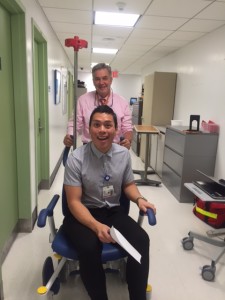EM Categorical: General Info
 The categorical emergency medicine residency at Kings County Hospital / SUNY Downstate is a 4-year academic program with a total of 73 residents. In addition, we also have a 5-year combined IM/EM residency program with a total of 20 residents. With 93 residents, our training program is one of the largest, most diverse emergency medicine residencies in the world.
The categorical emergency medicine residency at Kings County Hospital / SUNY Downstate is a 4-year academic program with a total of 73 residents. In addition, we also have a 5-year combined IM/EM residency program with a total of 20 residents. With 93 residents, our training program is one of the largest, most diverse emergency medicine residencies in the world.
The most basic goal of residency education is to instruct physicians in training in the core competencies as described by the ACGME guidelines in order to prepare our residents to competently practice emergency medicine. This is accomplished through quality ED and off-service rotations, as well as unique experiences offered through our emergency ultrasound, high-fidelity simulation, as well as experiences through the administration, education, and international divisions. A carefully planned didactic curriculum augments resident education and prepares residents for careers in academic medicine. It is the vision of this program to train the future leaders of our specialty. We are fully engaged in ensuring that every graduate has the opportunity to reach their full potential.
Our clinical training sites offer experience in both academic and community settings. Resident exposure to a vast spectrum of pathology ensures that residents are exceptionally well-trained in both the clinical and the procedural aspects of emergency medicine.
Residents are provided with the tools they require to succeed in a fulfilling and sustainable career in emergency medicine. The EM training program at Kings County Hospital / SUNY Downstate offers our residents exposure to the full breadth of opportunities available in our specialty, and the sub-specialties of emergency medicine. Regular meetings between residents, faculty mentors, program directors, and the program coordinators ensures that the residency program is able to respond to residents’ needs in real time. This ensures constant feedback on how we can make our training program better.

Program Design
The principle of graduated responsibility guides the program design. Residents assume greater responsibility with each year of training, fostering growth and maturity during their training.
First year residents in the emergency department are encouraged to immerse themselves in their cases, and learn as much as possible from their patient encounters. The learning curve is steepest during this year as residents form the foundation for their clinical acumen.
As residents move into their second year, they begin increasing their efficiency while continuing to master the basics of emergency medicine. After completing the multiple critical care rotations, residents begin to learn how to manage undifferentiated critically ill patients in the emergency department. Residents at this level can move into one of our Mini-fellowship programs, a special program allowing them to receive specialized mentoring in a sub-specialty of emergency medicine.
 Third year residents begin to assert ownership over the clinical arena. They are accountable for large divisions of the department and must manage multiple patients simultaneously as well as precept and oversee junior residents. This year is marked by their role in leading the resuscitation team in the Critical Care Trauma area and the ED Observation Unit.
Third year residents begin to assert ownership over the clinical arena. They are accountable for large divisions of the department and must manage multiple patients simultaneously as well as precept and oversee junior residents. This year is marked by their role in leading the resuscitation team in the Critical Care Trauma area and the ED Observation Unit.
Fourth year residents are fully capable physicians who supervise the flow of the entire emergency department. Through the Pre-Attending role, the 4 th year resident runs the main emergency department, while supervising junior residents and medical students. Through this role, they act as a junior Attending, preparing for their future solo practice. The fourth year is also the time in which leadership skills are developed through rotations in administration, and residents can further explore their niche through elective months.